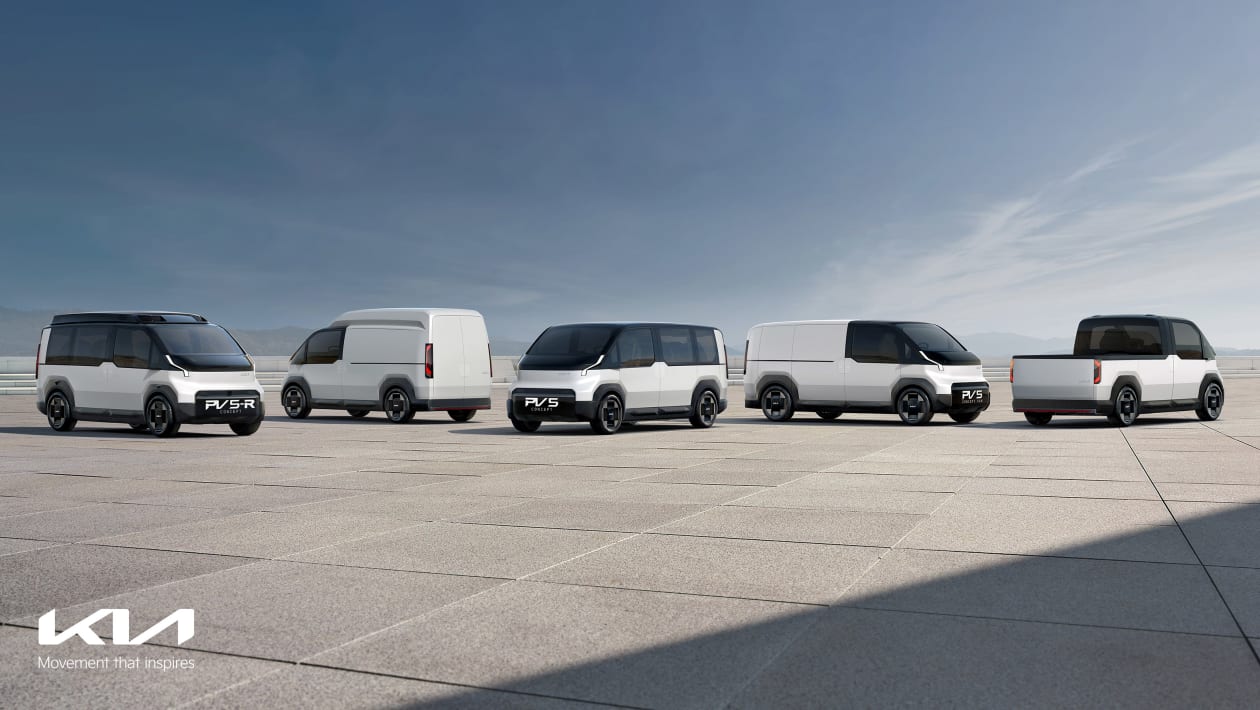Kia’s modular PBV architecture brings flexibility to cover a wide range of uses.
Not content with being a leader in the electric car sector, Kia is making plans to branch out into commercial vehicles with its new PBV system. PBV stands for Purpose Built Vehicle (it also stands for Platform Beyond Vehicle, which is the name of the overall commercial vehicle strategy that Kia is developing), and the company used the 2024 Consumer Electronics Show (CES) in Las Vegas to reveal three new van concepts called PV1, PV5 and PV7.
Led by the Kia PV5, which is due to hit showrooms in 2025, the models on display showcased the company’s ‘Easy Swap’ technology, which is designed to switch different ‘life modules’ into the back of a chassis cab-style platform. Kia plans to offer multiple versions of the PV5 that can be tailored for business and individual needs; at CES these included a taxi, delivery van and a camper. However, initially the PV5 will come as just a panel van while Kia refines the Easy Swap system.
The Easy Swap tech uses standardised electromagnetic and mechanical couplings to ensure security, while the platform’s modular construction features high-strength tubular steel and engineered polymers that reduce typical part counts by 55 per cent, while maintaining chassis rigidity.
The various PV5 models are all designed to perform different tasks. The people carrier is designed for ride sharing use, and is tall enough that passengers can stand up inside. The high-roof version, on the other hand, is a typical van with a walk-through to the cargo area to boost its practicality.
Elsewhere, a pick-up truck was also announced. However, this is going to be more like a chassis cab van than what we call a pick-up, with the same ride height as the standard PV5, while front-wheel drive will be standard for most models. Finally, there’s the robotaxi, which showcases the PV5’s electronic tech, and the scope for autonomous driving systems that can be added to the platform.
Powertrain information hasn’t been confirmed just yet, but an all-electric drivetrain will feature, and 400-volt charging tech will be standard from launch; the 800-volt system found in the Kia EV6 and EV9 will come at a later date.
This system will also be used to power the other two models showcased at CES: the PV7 and PV1. The PV7 is a typical large van like a Ford Transit or Mercedes Sprinter, while the PV1 is designed as an autonomous small urban delivery vehicle, similar in size to a Citroen Ami, and features pivoting wheels at all four corners so that it can turn in its own length.
Another model, the PV3, was teased at CES, which is a more conventional small electric van in the mould of the Renault Kangoo and Citroen Berlingo, although no more details were forthcoming on that model.
Speaking ahead of the unveiling, Kia CEO Ho Sung Song said, “Kia’s PBV business represents our vision of going beyond the traditional concept of automobiles by fulfilling the unmet needs of diverse customers and communities through optimised vehicles and services catering to specific market and business circumstances.
“Kia PBVs will be an enabler of business innovation thanks to our customer-centric management system, EV mass production expertise, and the Hyundai Motor Group’s rapidly developing SDx strategy and related future businesses,” he said. “We are excited to show that we are fully prepared to become the first mover in the global PBV market.”
The concepts look like they aren’t too far removed from production, and all the models on show are typical one-box designs. There are clean lines, although the LED exterior lighting is familiar to Kia’s latest electric cars.
There are large doors for easy access, while the cab features a desk-like dashboard that can be used as a mobile office. In the rear, each model features plenty of space and a flat load area to suit a variety of needs, while an integrated rail system for the floor, ceiling and sides offers versatility.
The PV5 will be the first model to appear in 2025, and it will include advanced software connectivity as a precursor to introducing autonomous driving and delivery services. This is the initial phase of Kia’s commercial vehicle plans, with phase two introducing the PV7 and PV1 in 2028/29, as well as integrated AI and fully customisable systems that will be able to accommodate any use case possible, according to Kia.
Phase three will see the introduction of bespoke mobility solutions and connected self-driving vehicles that are part of a ‘smart city’ system, which is seen as an essential step on the path towards autonomous driving technology.






